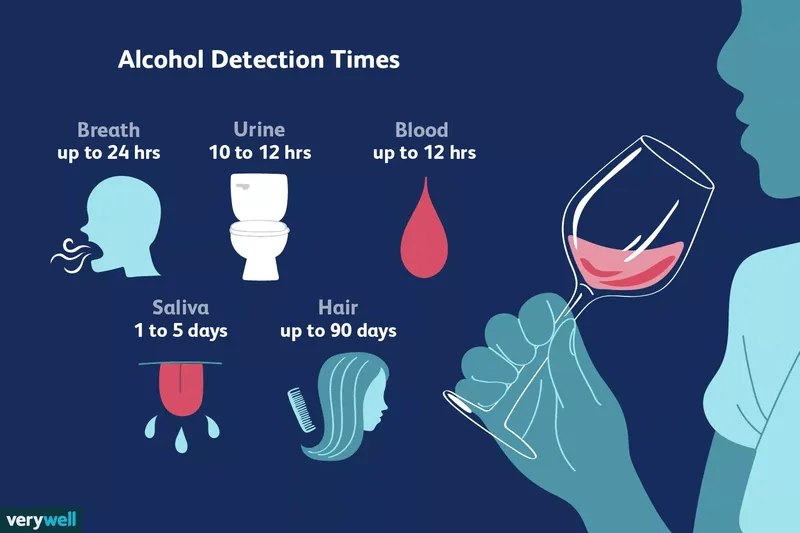The Ultimate Guide to Alcohol Elimination: How Long Does Alcohol Stay in Your System?
Understanding how long alcohol remains in your system is vital for your health, safety, and making responsible choices. The duration alcohol is detectable, and its effects are felt, isn't universal; rather, how long alcohol stays in your system depends on the individual. Factors like your age, body mass, genetics, and overall health significantly influence metabolism and elimination rates. Generally, alcohol can be detected in various bodily fluids and hair for periods ranging from a few hours to several months. Knowing these timelines helps prevent dangerous interactions, avoid impairment, and understand the risks associated with alcohol consumption.
While not a controlled substance, alcohol misuse carries significant health risks, including the potential for physical and psychological dependence, and can contribute to alcohol use disorder (AUD). Being informed empowers you to manage your intake wisely and seek help if needed.
Table of Contents
- Understanding Alcohol's Immediate Impact and Duration
- Alcohol Detection Times in the Body
- Key Factors Influencing Alcohol Elimination
- Dispelling Myths: Accelerating Alcohol Elimination
- Recognizing and Responding to Alcohol Overdose
- Navigating Support for Alcohol Use Concerns
1. Understanding Alcohol's Immediate Impact and Duration
The journey of alcohol through your body begins almost immediately upon ingestion. Within minutes, you can start to feel its effects as it rapidly absorbs from your stomach and small intestine into your bloodstream. From there, it travels to your central nervous system, including your brain and spinal cord, acting as a depressant that alters neural communication. This rapid absorption means that the onset of effects is quick, often surprising individuals who might underestimate its potency (Harvard, 2024).
Initially, you might experience a sense of relaxation, reduced anxiety, or increased sociability. However, as your blood alcohol concentration (BAC) rises, so does your level of intoxication. This can manifest in various ways, from heightened talkativeness to more concerning behaviors like aggression or impaired judgment. Other common signs of intoxication include euphoria, loss of coordination, diminished inhibitions, slowed reaction times, and slurred speech. For example, attempting complex tasks like driving or operating machinery becomes increasingly dangerous, as your senses and motor skills are significantly compromised. The half-life of ethanol, the alcohol found in beverages, is approximately 4 to 5 hours, meaning it takes this long for half of the consumed alcohol to be eliminated from the bloodstream. However, this is an average, and the exact duration how long alcohol stays in your system depends on the individual physiological processing capabilities. Your body typically absorbs alcohol faster than it can metabolize it, leading to a continuous increase in BAC if consumption outpaces elimination. For instance, a 150-pound individual consuming one standard drink might see their BAC rise by about 0.02%, while their body can only eliminate approximately 0.016% per hour. This means even consuming one drink per hour can lead to a rising BAC, highlighting the importance of mindful drinking practices.
2. Alcohol Detection Times in the Body
The ability to detect alcohol in your body varies significantly based on the testing method used. Different tests target alcohol itself or its metabolites, which can linger for longer periods. Understanding these detection windows is crucial for medical, legal, and personal safety reasons. The timeframe for detection is an estimate, as how long alcohol stays in your system depends on the individual metabolic rate and other personal factors.
Here's a breakdown of typical detection times for various tests:
- Breath (Breathalyzer Test): Alcohol can be detected in your breath for up to 24 hours. Breathalyzers measure the alcohol content in the air exhaled from your lungs, which correlates directly with your blood alcohol level. This method is commonly used by law enforcement due to its speed and non-invasiveness.
- Urine (Traditional Urine Test): A standard urine test can detect alcohol for approximately 10 to 12 hours. These tests look for the presence of ethanol directly.
- Blood (Blood Test): Alcohol can appear in a blood test for up to 12 hours. Blood tests are considered highly accurate as they directly measure the amount of alcohol circulating in your bloodstream.
- Saliva (Saliva Test): Alcohol can be detected in saliva for a slightly longer period, typically between 24 to 48 hours. Similar to breath tests, saliva tests are convenient and provide a quick indication of recent alcohol consumption.
- Hair (Hair Follicle Drug Test): Hair follicle tests offer the longest detection window, capable of identifying alcohol metabolites for up to 90 days. This is because alcohol metabolites become incorporated into the hair as it grows, providing a historical record of consumption.
Beyond these standard tests, a specialized method called the EtG (ethyl glucuronide) test is often employed to confirm abstinence, especially for individuals under legal or medical mandates. The EtG test measures a specific alcohol metabolite that can be found in blood, hair, nails, and most commonly, urine. A urine EtG test can detect this metabolite for 3 to 5 days after alcohol consumption, significantly longer than a traditional urine test. It's important to note, however, that an EtG test indicates recent exposure to alcohol, not necessarily current intoxication. Interestingly, the EtG test can even yield a false positive from mere exposure to alcohol-containing household products like vanilla extract, mouthwash, certain medicines, or cosmetics. This highlights the sensitivity of these advanced detection methods and the complexities of interpreting results. For example, using an alcohol-based mouthwash just before a breath or saliva test could temporarily elevate readings, leading to a false positive for recent consumption.
3. Key Factors Influencing Alcohol Elimination
The rate at which your body processes and eliminates alcohol is not uniform. Numerous physiological and external factors contribute to this variability, meaning how long alcohol stays in your system depends on the individual unique biological makeup and circumstances. Understanding these influences can help you anticipate how your body might react to alcohol and manage your intake more responsibly.
- Genetics: Your genetic heritage plays a significant role in how efficiently your body metabolizes alcohol. Just as family history can predispose individuals to alcohol use disorder, genetic variations can affect the production of enzymes crucial for breaking down alcohol in the liver. Some individuals may have enzymes that work faster or slower, directly impacting elimination time (Harvard, 2024).
- Sex: Biological sex is a major determinant. Women generally have proportionally more body fat and less body water than men. Since alcohol is water-soluble, it becomes more concentrated in a woman's body, leading to a higher BAC from the same amount of alcohol and often taking longer to eliminate from their systems. This physiological difference means women often feel the effects of alcohol more intensely and for a longer duration.
- Body Fat: Related to sex, an individual's body composition, specifically the amount of body fat, influences alcohol distribution. The more fat an individual has, the less body water is available for alcohol to dilute into, resulting in a higher concentration and a longer time for the alcohol to be processed and excreted.
- Ethnicity: Certain ethnic groups, particularly those of East Asian descent, often possess a genetic variation that affects alcohol metabolism. They may produce insufficient amounts of acetaldehyde dehydrogenase, a key enzyme responsible for breaking down acetaldehyde, a toxic byproduct of alcohol. This leads to a buildup of acetaldehyde, causing symptoms like facial flushing, headaches, dizziness, and nausea—colloquially known as "Asian flush" or "Asian glow." This genetic predisposition means alcohol can linger longer and cause more pronounced adverse reactions.
- Aging: As people age, liver function naturally slows down. The liver is the primary organ responsible for metabolizing alcohol, so a less efficient liver in older adults means it takes longer to process and excrete alcohol. Furthermore, many aging adults take medications that can impact liver function, further slowing the alcohol elimination process and potentially leading to dangerous interactions.
- Food Consumption: Eating before and during alcohol consumption significantly impacts absorption rates. Approximately 20% of alcohol is absorbed from the stomach, with the remainder absorbed in the small intestine. Food in the stomach acts as a buffer, slowing the rate at which alcohol reaches the bloodstream. This means intoxication may be delayed and less intense, but it also prolongs the overall detection period as alcohol remains in the digestive system for a longer time before being fully absorbed and metabolized. For example, drinking on an empty stomach will lead to a much faster onset of effects compared to having a full meal beforehand.
- Medications: Many prescription and over-the-counter medications can interfere with alcohol absorption and metabolism, often enhancing its effects or prolonging its stay in the system. It's crucial to be transparent with your healthcare provider about your alcohol consumption, especially when prescribed new medications. Examples of medications known to interact include anti-anxiety drugs, antidepressants, antibiotics, allergy medications, and diabetes medications. Combining these with alcohol can lead to increased drowsiness, impaired coordination, liver damage, or other severe health complications.
- Frequency and Speed of Use: How quickly and how much alcohol you consume, along with the alcohol content of your beverages, are critical factors. Binge drinking, defined as five or more drinks for men or four for women in a single session, overwhelms the liver's capacity, leading to a significantly prolonged elimination time. For instance, after a night of binge drinking, it's entirely possible to still have a detectable BAC the following morning, making activities like driving unsafe and potentially leading to legal issues, even if you feel sober.
4. Dispelling Myths: Accelerating Alcohol Elimination
Despite popular beliefs and common remedies, there is no magic trick to speed up the rate at which your body eliminates alcohol. The liver processes alcohol at a relatively constant rate, averaging about 0.016% Blood Alcohol Concentration (BAC) per hour. This rate is largely determined by the liver's enzymatic capacity, which cannot be significantly altered by external interventions. Therefore, the notion that certain actions can "sober you up" quickly is a dangerous misconception.
Many people mistakenly believe that drinking coffee, consuming large amounts of water, taking a cold shower, or even inducing vomiting can accelerate the elimination process. However, these methods only address the superficial symptoms of intoxication or might slightly alter how you perceive your level of impairment, without actually reducing the alcohol content in your bloodstream. For instance, coffee might make you feel more alert, but it does not diminish the alcohol's depressant effects on your brain or improve your coordination. Similarly, drinking water can help with dehydration associated with alcohol consumption, but it won't make your liver work faster (Harvard, 2024). Vomiting might expel some unabsorbed alcohol from your stomach, but once alcohol has entered your bloodstream, it's already on its way to being processed by the liver.
The only truly effective method for lowering your BAC and eliminating alcohol from your system is time. Your body needs to metabolize the alcohol, and this process cannot be rushed. If you anticipate needing to pass a breath, blood, or urine test for alcohol, the most reliable strategy is to allow as much time as possible to elapse between your last drink and the test. This waiting period allows your liver to do its work naturally. This reality underscores why how long alcohol stays in your system depends on the individual metabolic clock and not on quick fixes.
Consider the following estimated times for alcohol elimination based on varying BAC levels:
| Blood Alcohol Concentration (BAC) | Estimated Time for Elimination |
|---|---|
| 0.02% | 1 hour 15 minutes |
| 0.04% | 2 hours 30 minutes |
| 0.06% | 3 hours 45 minutes |
| 0.08% | 5 hours |
| 0.10% | 6 hours 15 minutes |
| 0.15% | 9 hours 30 minutes |
Note: These times are estimates for a healthy, functioning liver. Heavy or long-term alcohol consumption can impair liver function, potentially extending these elimination times significantly.
This table highlights that even a legally intoxicated BAC of 0.08% requires a substantial amount of time to clear, emphasizing the dangers of driving or performing other critical tasks even hours after your last drink. The best approach to alcohol consumption is always moderation and patience, allowing your body the necessary time to recover safely.
5. Recognizing and Responding to Alcohol Overdose
Consuming a large quantity of alcohol in a short timeframe can lead to a medical emergency known as alcohol poisoning or alcohol overdose. This is a life-threatening condition that occurs when the amount of alcohol in the bloodstream becomes toxic, overwhelming the body's ability to process it and shutting down vital bodily functions. According to the Centers for Disease Control and Prevention (CDC), alcohol poisoning claims an average of six lives daily, underscoring its severe risks.
The danger arises because alcohol is a central nervous system depressant. When consumed excessively, it begins to suppress areas of the brain that control essential life-sustaining functions such as breathing, heart rate, and body temperature regulation. This suppression can lead to a cascade of critical failures, particularly when combined with other drugs or medications. The severity of an overdose can also depend on individual factors like tolerance and body mass, illustrating that how long alcohol stays in your system depends on the individual capacity to cope with high levels of alcohol.
Key symptoms of alcohol poisoning include:
- Slow or Irregular Breathing: Fewer than eight breaths per minute, or gaps of 10 seconds or more between breaths. This is a critical indicator that respiratory function is compromised.
- Clammy, Pale, or Blue-Tinged Skin: This signifies poor circulation and oxygen deprivation, often noticeable on the lips or fingertips.
- Confusion: Disorientation, an inability to understand or respond to questions, or general unresponsiveness.
- Decreased Gag Reflex: The natural reflex that prevents choking during vomiting is suppressed, increasing the risk of aspiration (inhaling vomit into the lungs).
- Extreme Sleepiness or Loss of Consciousness: The person may be difficult to wake up, or completely unconscious (passed out).
- Seizures: Uncontrolled electrical activity in the brain due to severe chemical imbalance.
- Slow Heart Rate: A dangerously low pulse indicates cardiovascular distress.
- Low Body Temperature (Hypothermia): Alcohol can cause blood vessels to dilate, leading to rapid heat loss and a drop in core body temperature, even in warm environments.
- Vomiting While Unconscious: This is extremely dangerous due to the suppressed gag reflex, posing a high risk of choking. For example, if someone passes out after drinking heavily and then starts to vomit, it's a clear sign of severe distress and immediate danger.
If you suspect someone is experiencing alcohol poisoning, it is imperative to act quickly. Call 911 immediately. While waiting for emergency medical help to arrive, ensure the person is safe. Turn them onto their side to prevent choking if they vomit, and try to keep them warm. Do not leave them alone, and do not try to make them walk around or drink coffee, as these actions can worsen their condition. Your prompt response can be the difference between life and death.
6. Navigating Support for Alcohol Use Concerns
For individuals who have been drinking heavily or regularly, deciding to stop or significantly reduce alcohol intake can be a challenging but critical step towards better health. However, suddenly discontinuing alcohol use can trigger a range of physical and psychological withdrawal symptoms. The intensity of these symptoms is highly variable, depending on the duration and quantity of alcohol consumed, again highlighting that how long alcohol stays in your system depends on the individual history of use.
In severe cases, alcohol withdrawal can manifest as delirium tremens (DTs), a potentially life-threatening condition characterized by severe confusion, hallucinations, rapid heart rate, high blood pressure, and seizures. DTs typically emerge two days to a week after the last drink and require immediate medical intervention due to the high risk of complications. This is why supervised medical detoxification is often recommended for individuals with significant alcohol dependence.
When you are ready to address concerns about your alcohol consumption, numerous resources are available to provide support and guidance. A crucial first step is to consult your primary care physician. They can assess your individual situation, provide medical advice, and refer you to appropriate treatment options or specialists. Open and honest communication with your doctor about your drinking habits is essential for receiving the most effective care.
Many individuals find invaluable support through peer-led groups such as Alcoholics Anonymous (AA). These groups offer a safe, confidential environment for sharing experiences, fostering mutual support, and navigating the path to recovery. AA meetings, available both in-person and online, can help you feel less isolated and more connected during your journey. For instance, attending regular meetings can provide a sense of community and accountability that is vital for long-term sobriety.
Additionally, the Substance Abuse and Mental Health Services Administration (SAMHSA) National Helpline at 1-800-662-HELP (4357) is an excellent resource. This confidential helpline provides free information, support, and referrals to local treatment facilities, support groups, and community-based organizations. They can assist you in finding suitable resources tailored to your needs, whether you are seeking immediate crisis intervention or long-term recovery programs. Exploring different avenues of support allows you to find what resonates best with your personal recovery journey, ensuring you have the tools and assistance needed to achieve your health goals. Seeking help is a sign of strength, and a wealth of support is available to guide you towards a healthier, alcohol-free, or moderated lifestyle.





